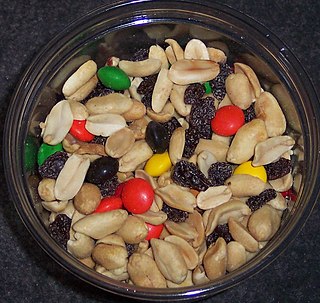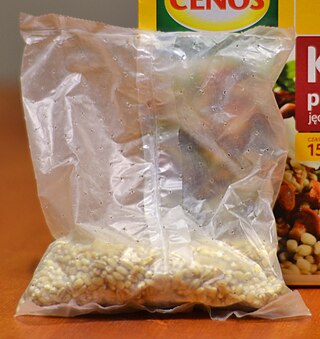The following outline is provided as an overview of and topical guide to meals:

A bento is the Japanese iteration of a single-portion take-out or home-packed meal, often for lunch. Outside Japan, it is common in other East and Southeast Asian culinary styles, especially within Chinese, Korean, Singaporean, Taiwanese cuisines and more, as rice is a common staple food in the region. The term bento is derived from the Chinese term biandang, which means "convenient" or "convenience".

The Meal, Ready-to-Eat (MRE) is a self-contained individual United States military ration used by the United States Armed Forces and Department of Defense. It is intended for use by American service members in combat or field conditions where other food is not available. MREs have also been distributed to civilians as humanitarian daily rations during natural disasters and wars.

The C-ration was a United States military ration consisting of prepared, canned wet foods. They were intended to be served when fresh or packaged unprepared food was unavailable, and survival rations were insufficient. It was replaced by the similar Meal, Combat, Individual (MCI) in 1958; its modern successor is the Meal, Ready-to-Eat (MRE).

Finnish cuisine is notable for generally combining traditional country fare and haute cuisine with contemporary continental-style cooking. Fish and meat play a prominent role in traditional Finnish dishes in some parts of the country, while the dishes elsewhere have traditionally included various vegetables and mushrooms. Evacuees from Karelia contributed to foods in other parts of Finland in the aftermath of the Continuation War.
Elevenses is a short break taken at around 11:00 a.m. to consume a drink or snack. The names and details vary among countries.

A lunch box refers to a hand-held container used to transport food, usually to work or to school. It is commonly made of metal or plastic, is reasonably airtight and often has a handle for carrying.
Tiffin is a South Asian English word for a type of meal. It refers to a light breakfast or a light tea-time meal at about 3 p.m., consisting of typical tea-time foods. In certain parts of India, it can also refer to the midday luncheon or, in some regions of the Indian subcontinent, a between-meal snack. When used in place of the word "lunch", however, it does not necessarily mean a light meal.

The K-ration was a United States military ration consisting of three separately boxed meal units: breakfast, dinner, and supper. It was originally intended as an individually packaged daily ration for issue to airborne troops, tank crews, motorcycle couriers, and other mobile forces for short durations.

A paper bag is a bag made of paper, usually kraft paper. Paper bags can be made either with virgin or recycled fibres to meet customers' demands. Paper bags are commonly used as shopping carrier bags and for packaging of some consumer goods. They carry a wide range of products from groceries, glass bottles, clothing, books, toiletries, electronics and various other goods and can also function as means of transport in day-to-day activities.
Norwegian cuisine in its traditional form is based largely on the raw materials readily available in Norway and its mountains, wilderness, and coast. It differs in many respects from continental cuisine through the stronger focus on game and fish. Many of the traditional dishes are the result of using conserved materials, necessary because of the long winters.

The Individual Meal Pack or IMP is one type of field ration used by the Canadian Forces. The IMP is designed so that a continuous diet provides all the nutrition needed to sustain a service-person in the field. The IMP meets Canada's nutrition requirements, with the exception of calcium and folic acid, which are not significant if the consumption period of rations is less than 30 (consecutive) days. IMPs provide 1,200–1,400 calories (5.0–5.9 MJ) per meal.
Lunch is a meal eaten around the middle of the day. It is commonly the second meal of the day, after breakfast, and varies in size by culture and region.

Tiffin carriers or dabbas are a kind of lunch box used widely in Asia and the Caribbean for tiffin meals. From India, they spread to Pakistan, Cambodia, Thailand, Indonesia, Malaysia, Singapore, Fiji, Mauritius, Guyana, Suriname and Trinidad and Tobago, where they are now widely used. They are also used extensively in Hungary, primarily to transport restaurant meals for consumption at home. The Hungarian version typically contains soup, a main course, and piece of cake. A very similar device is called Henkelmann in Germany. It is usually round or oval similar to military mess kits. The Henkelmann was very popular until the 1960s, but is very rarely used by Germans today.

A bag is a common tool in the form of a non-rigid container, typically made of cloth, leather, paper or plastic. The use of bags predates recorded history, with the earliest bags being lengths of animal skin, cotton, or woven plant fibers, folded up at the edges and secured in that shape with strings of the same material. Bags can be used to carry items such as personal belongings, groceries, and other objects. They comes in various shapes and sizes, often equipped with handles or straps for easier carrying.

Dosirak (Korean: 도시락), also known as Gwakbap (곽밥) refers to a packed meal, often for lunch. It usually consists of bap and several banchan. The lunch boxes, also called dosirak or dosirak-tong, are typically plastic or thermo-steel containers with or without compartments or tiers. Dosirak is often home-made, but is also sold in train stations and convenience stores.

A snack is a small portion of food generally eaten between meals. A snack is often less than 200 calories, but this can vary. Snacks come in a variety of forms including packaged snack foods and other processed foods, as well as items made from fresh ingredients at home.

Boil-in-bags are a form of packaged food products in which bagged food is heated or cooked in boiling water. Plastic bags can be solid and impermeable for holding frozen foods; alternatively, bags can be porous or perforated to allow boiling water into the bag.

A meal is an eating occasion that takes place at a certain time and includes consumption of food. The names used for specific meals in English vary, depending on the speaker's culture, the time of day, or the size of the meal.















